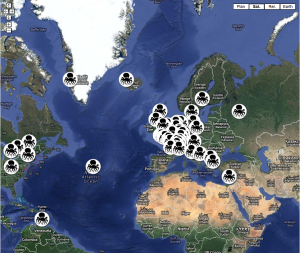Projet Octopus
Projet Octopus / Pratiques et numérique / 2012-2013 / Ecole Supérieure des Beaux-Arts, Montpellier
Afficher Projet Octopus sur une carte plus grande (Google Maps).
Vous pouvez afficher directement le Projet Octopus sur Google Earth (cliquez-ici)
Annie Abrahams – Yacine Ait Kaci – Pierre Alferi – Franck Ancel – Andreas Angelidakis – Olivier Auber – Jeremy Bailey – Pascale Barret – Alain Barthélémy – Pierre Belouin – Zoe Beloff – Nicola Bergstrom Hansen Benjamin Blaquart – Sarah Bodman – Ludovic Borel – Anne Sophie Bosc – Olivier Bosson – Harry Burke – Lucille Calmel – Marco Cetera – Shu Lea Cheang – Thomas Cheneseau – Curt Cloninger – Claude Closky – Clôde Coulpier – Serge Comte – Agnès de Cayeux – Caroline Delieutraz – Alain Dellanegra-Kaori Kinoshita – Carla Demierre – Lloyd Dunn –Maurizio Di Feo – DinahBird – Constant Dullaart – Jasper Elings – Ursula Endlicher – Adam Ferriss – Nicolas Frespech –Nathalie Fougeras – Benjamin Gaulon – Emmanuelle Gibello – Emilio Gomariz – David Guez – Pol Guezennec – Olivier Guillerminet – Anne Horel – Jodi – Eléonore Joulin – Jérôme Joy – Joséphine Kaeppelin – Olga Kisseleva – Anne Laplantine – Pierre-Nicolas Ledoux – Yann Le Guennec – Julien Levesque – Silvio Lorusso – André Lozano – Sara Ludy – Jonas Lund – Sally McKay – Miltos Manetas – Laura Mannelli – M.E.R.C.U.R.E – Rosa Menkman – Jan Mensen – Albertine Meunier – Lorna Mills – Joachim Montessuis – Antoine Moreau – Mouchette – Brenna Murphy – Eva Papamargariti – David Paton – Elodie Petit – Gabriel Peyre – Angelo Plessas –Jim Punk – Sabrina Ratté – Jean-Philippe Renoult – Annick Rivoire – Rafaël Rozendaal – Nicolas Sassoon – Chris Shier – Antoine Schmitt – Sebastian Schmieg – Hugo Scibetta – Rick Silva – Yoshi Sodeoka – Jeff Thompson – Miyö Van Stenis – Paul Sztulman – Systaime – Gwenola Wagon – Christine Webster…
Picto “Islandic Octopus” (Creative Commons) : Alkemia. http://alkemia.tumblr.com
FR (English below)
Projet Octopus // pour une exposition en ligne
Am I an octopus ? Cette question de William Burroughs est moins improbable qu’il n’y paraît quand on considère cet animal polymorphe et rusé. De la créature redoutable de “Vingt mille lieues sous les mers” au poulpe à la “douce vertu communicative” de Lautréamont et aux pieuvres d’aquarium de Jean Painlevé sans oublier les accouplements érotiques dont l’animal s’avère capable chez Hokusai, ces mollusques ne cessent d’attirer l’attention des artistes et d’attiser l’imagination des scientifiques.
Ces créatures invertébrées montrent leurs émotions en couleur. Leurs affects apparaisent directement sur la surface de leur peau. Plastique et changeant, le poulpe est “une visualité mutante” (W.B.) en mode d’affichage immédiat. C’est l’animal visuel/tactile par excellence. Munie d’une multitude de neurones distribués tout au long de ses 8 tentacules, la pieuvre prêche la décentralisation de la pensée. Dotée d’une mémoire que les scientifiques appellent spatiale, elle est de surcroît capable de parcours étonnants.
Annonçant et accompagnant le colloque “Formes et processus des pratiques artistiques dans la culture numérique” qui se tiendra le 26 & 27 novembre 2012 au Centre Rabelais à Montpellier, le Projet Octopus est créé par pratiquesetnumerique.com de l’Ecole des beaux-arts de Montpellier. Nous avons invité des artistes et des chercheurs à construire une exposition qui est un processus (de forme) tentaculaire, se passant entre boîtes de messagerie croisées et sur une googlecarte. Partant d’une idée initiale de Nicolas Frespech, cette exposition se déroule finalement en deux temps. Les participants sont d’abord invités à répondre à 4 questions. Une fois remplis et retransmis, ces formulaires tentaculaires déterminent les œuvres présentées et font partie du réseau. Externalisation partagée, existence distribuée.
P.S. : Les échos du titre de l’exposition avec l’univers de James Bond évoquent la nature augmentée, par des gadgets de toutes sortes, du célèbre agent secret.
M. A.
Commissariat : Madeleine Aktypi et Nicolas Frespech avec la participation de poptronics.fr
Picto : “Islandic Octopus” (Creative Commons) : Alkemia
FaceBook : https://www.facebook.com/ProjetOctopus
Twitter/Identi.ca : #pratiquesnum
Projet Octopus / / towards an online exhibition
Am I an octopus? William Burroughs’ question may seem unlikely but it is not really. Not if you consider that cunning and polymorphic animal. Think of the fearsome creature of Twenty Thousand Leagues Under the Sea or the “sweet virtue of communication” of Lautréamont’s octopus or even the aquarium octopuses that Jean Painlevé filmed, not to mention the cephalopod’s erotic couplings as depicted by Hokusai. These molluscs attract the attention of artists and excite the imagination of scientists. These invertebrates show their true colors: they exhibit their emotions directly on the surface of their skin. Plastic and changeable, the octopus is “a mutant visuality” (W.B.) attuned to real-time display. It is the ultimate visual/tactile animal. Equipped with a multitude of neurons distributed all along its 8 tentacles, the octopus preaches decentralized thinking. Endowed with a memory that scientists call spatial, the octopus is also capable of tracing amazing trails.
To announce and accompany the Symposium “Forms and processes in art practices within digital culture” that takes place on 26 & 27 November 2012 at Centre Rabelais in Montpellier, pratiquesetnumerique.com of the School of Fine Arts of Montpellier has invited artists and researchers to curate a self-growing online process whose form simulates the tentacles of the mollusk’s intelligence and unique memory via e-mail boxes and a googlemap.
Based on an initial idea by Nicolas Frespech, the show finally unfolds in two phases. Participating artists and researchers are asked to answer 4 questions. Once completed and forwarded, these forms determine the artworks shown and become part of the web. Shared externalization / distributed existence.
P.S.: The title of the exhibition also evokes the gadget-packed universe of James Bond, the renowned secret agent.
M.A.
Curators: Madeleine Aktypi and Nicolas Frespech in association with poptronics.fr
Picto : “Islandic Octopus” (Creative Commons) : Alkemia
FaceBook : https://www.facebook.com/ProjetOctopus
Twitter/Identi.ca : #pratiquesnum
*N’hésitez pas à utiliser l’option > Plus > Zoomer
Dernière actualisation : 20/12/2013/

